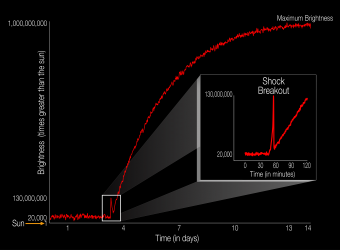 The brilliant flash of an exploding star’s shockwave—what astronomers call the “shock breakout”—has been captured for the first time in the optical wavelength or visible light by NASA's planet-hunter, the Kepler space telescope.
The brilliant flash of an exploding star’s shockwave—what astronomers call the “shock breakout”—has been captured for the first time in the optical wavelength or visible light by NASA's planet-hunter, the Kepler space telescope.
An international science team led by Peter Garnavich, an astrophysics professor at the University of Notre Dame in Indiana, analyzed light captured by Kepler every 30 minutes over a three-year period from 500 distant galaxies, searching some 50 trillion stars. They were hunting for signs of massive stellar death explosions known as supernovae.
In 2011, two of these massive stars, called red supergiants, exploded while in Kepler’s view. The first behemoth, KSN 2011a, is nearly 300 times the size of our sun and a mere 700 million light years from Earth. The second, KSN 2011d, is roughly 500 times the size of our sun and around 1.2 billion light years away.
Read the full story at NASA Ames News

